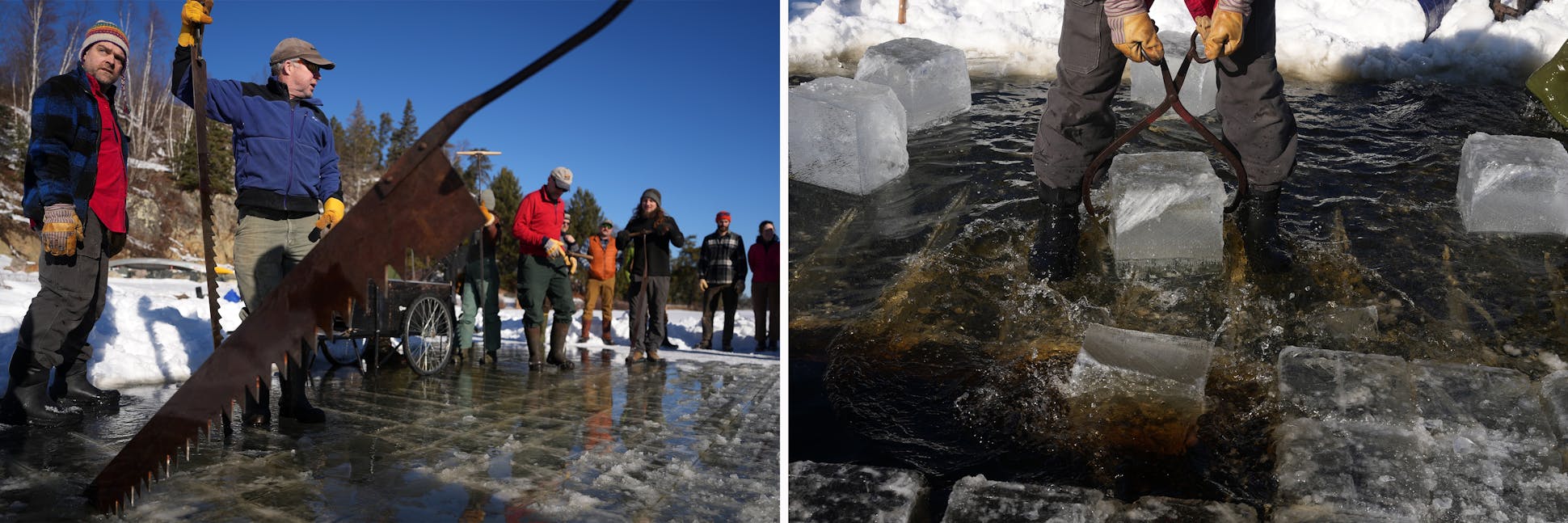Belle of Will Steger's Ice Ball this year is 'perfect ice'
NEAR ELY, MINN. — Volunteers sloshed through ankle-deep lake-water, an assembly line sending large blocks of ice splashing and sliding to a pileup near the shore where they would later become the base of Will Steger's rustic refrigeration system.
For decades, the explorer known for polar expeditions and climate education has kept his perishables cool the old-fashioned way: tucked into a root cellar half-filled with ice harvested from pristine Pickett's Lake, a private body of water on his acreage off the grid in northern Minnesota. This requires sawing through the ice to make cubes, plucking them from the water, then hauling them to the cellar dug into a hill at the base of the Steger Wilderness Center, the five-story education and leadership academy devoted to sustainability that he is building.
This year's Ice Ball, as Steger calls it, drew dozens of helpers to this land at the edge of the Boundary Waters Canoe Area Wilderness. The event is held on the first Saturday in February, this year a sunny and 40-degree day. In a year of record-high temperatures, Steger has found an anomaly on the lake — a quality of ice he hasn't seen since he started harvesting it more than 50 years ago.
"Totally black ice, all the way through," Steger said in the days before the event. "Perfect ice."
Steger attributed it to a late freeze on Pickett's Lake, followed by consecutive days of below-freezing temperatures and a lack of precipitation. There wasn't much snow to shovel off the ice — not at the point of harvest or at the nearby circle rink created by the site's seasonal caretakers. In past years, part of the Ice Ball process has included shaping the cubes by trimming the crunchy slag made from frozen slush.
This year there was no need.
"These could go in cocktail glasses," said volunteer Mike Gilgosch, who lives near Ely and has been coming to the Ice Ball since 2018. The cubes were clear.
In preparation for the harvest, the ice sheet was scored using a chain saw docked on sled runners. Volunteers used long, rustic hand saws to cut nearly uniform 12-inch cubes, then metal pincers to pluck the blocks from the lake and slide them into a pile. The hole in the ice grew and lake water spilled over the edges, making the work area wet, slippery and slushy.
"I feel like a penguin," said Aurora Wahlstrom, a caretaker on the property who tromped through the ankle-deep water, then hoisted ice and slid it from one end to the other.
Layers of clothing were quickly shed; jackets piled on the rocks near a row of canoes.
A team of two Shires and two Belgian horses, each more than 17 hands high and weighing more than a ton, pulled a sled with a hand-painted sign "Steger Wilderness Ice Harvest." The horses, outfitted with sleigh bells — more for style than function — tugged loads of ice from near the lake, up a hill and around a curve to the cellar. It's a job befitting of a Bobcat — which was the backup plan if there wasn't enough snow to pull the sleigh.
The team's driver, too, favors traditional ways.
"This is the way it was done," said Mike Berthiaume of Anvil B Farm in Rockford, Minn., who provides the draft horses for regional events that might benefit from old-school horsepower.
More volunteers pulled the cubes from the horse-pulled trailer, then docked them on waist-high horizontal boards, a variation on a conveyor belt, and slid them to the back of the cellar. They were stacked with sawdust in between the cubes.
Steger, 79, with his signature mess of hair, was here and there during the Ice Ball. He drove down a path on a Bobcat, then popped up on the fringes of a crowd that throughout the day would come to include Wilderness Center workers, two of his siblings, friends from town and members of his expedition teams — like John Stetson, whose specialty is sled dogs. Stetson shared a blur of a story of a harrowing airplane landing with Steger's team in the 1980s, then went back to packing ice into the cellar.
After the rush of the ice harvest and more casual ice packing, that particular work was done — there is often some kind of work going on here, though — and the pace slowed. Ham sandwiches and cookies were served. Volunteers scattered to different corners of the land. Someone cracked a beer. Families slid lazily across the ice rink on boots. Some gathered on the deck of the sauna or toured the Steger Center, which he designed, that sits high on the property.
Steger has trimmed attendance at the Ice Ball in recent years to make it more local and therefore more carbon efficient. In its heyday, it drew volunteers from the Twin Cities area who stuck around for live music after the work was done. A self-sustainable homestead has always been the goal, one that Steger has stuck to and the people around him have signed on to, according to site caretaker Trevor Dean.
"It's cool to see so many people here working toward a common goal," he said.



